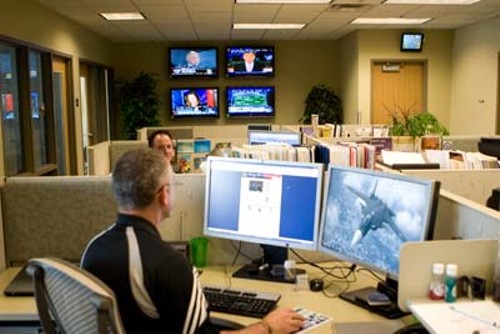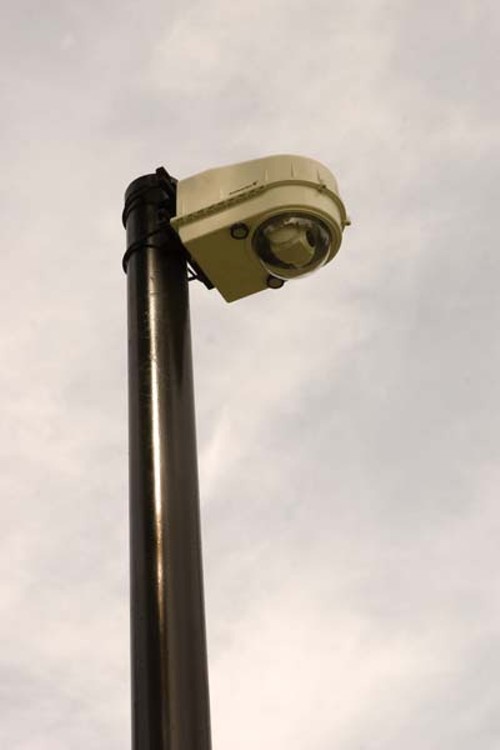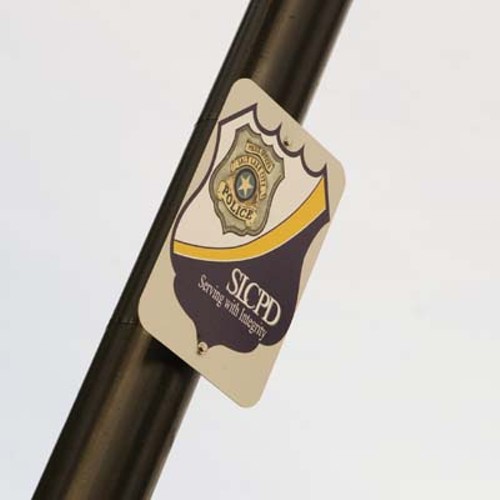They're Watching You
What no one is telling you about the proposed cop shop in Library Square.
By Ted McDonoughPage 2 of 3
The Fusion Center
Fusion centers stem from a call by the 9/11 Commission for more terrorist information-sharing between law enforcement. The George W. Bush administration helped with millions for surveillance research and a rollback of 30-year-old restrictions on government information gathering.
Federal anti-terrorism state grant programs morphed over the years to tackle all crime and later “all hazards.” Now, that money is finally beginning to roll into Salt Lake City. While some Utah legislators worried about the project becoming a costly unfunded mandate, for now, it seems state and city departments are happy to take the money.
The question no one is asking, Erickson says, is, “Why is there all of a sudden the need to spy on everybody around here? Where is the impending threat?”
The Utah Fusion Center was formally created in June 2007 when the Utah Department of Public Safety inked a memorandum-of-understanding with the FBI. But it wasn’t much to speak of—just a couple of state investigators sharing joint-terrorism task-force office space with the FBI in downtown Salt Lake City.
That’s changing with recent infusions of federal money. Today, the Utah
Fusion Center consists of five intelligence analysts, a few
administrators and parttime help from a federal Homeland Security
employee. An FBI employee is expected to move in soon. Annual salary
cost for state employees assigned to the fusion center is currently
around $600,000. And Utah recently hired an intelligence officer from a
center in Boston to run the operation.
Fusion-center staff
currently share space with a police training facility at 9750 S. 300
West, at the Larry H. Miller Campus of Salt Lake Community College. But
center directors say the state is talking to Salt Lake City about
moving the operation into one of the buildings the city hopes to
construct on or near Library Square with proceeds from a $125 million
public-safety bond to be taken to city voters in November.
Salt
Lake City Mayor Becker’s plans for a “civic campus” include a
public-safety building for police and fire departments and a separate
Emergency Operations Center built to Homeland Security standards to
withstand an attack by weapons of mass destruction. The full project
could only be realized with help from the state, which would bring in
the fusion center from Sandy and the state’s existing
emergency-operations center from a basement location at the state
Capitol complex. The Salt Lake City Mayor’s Office did not respond to
repeated City Weekly invitations to discuss the city’s involvement with the fusion center.
Whether
or not the state comes up with $40 million to help build the
three-story Emergency Operations Center structure shown in Salt Lake
City plans, the fortress building is scheduled to house the Salt Lake
Information Center, or SLIC, a new project that the Salt Lake City
Police Department hopes to launch by mid-June in current police
department headquarters on 200 South.
Salt Lake City Police
Chief Chris Burbank describes SLIC as a project to connect
law-enforcement records across the Salt Lake Valley with data-searching
software at a central location where police analysts will funnel
investigatory information to officers in the field.
Salt Lake
City Emergency Management Director Cory Lyman describes the pending
SLIC project as “basically Salt Lake’s portion of that [state] fusion
center.”
Mission Creep/ Creepy Missions
Salt
Lake finds itself in the pipeline for federal money for new spyware
purchases and intelligence efforts because of federal funding formulas
that in 2008 determined the Salt Lake Valley faces significant
threat—from earthquakes.
Lyman says the potential for a large
Wasatch Front quake to disrupt rail yards and interstate freeways was
likely “the driving event that put us at risk” in the eyes of Homeland
Security. So in 2008, the feds qualified the Salt Lake metropolitan
area for special grants through a program called the Urban Area
Security Initiative. Salt Lake City is the fiscal agent for the
countywide effort, explaining why initiative requests showed up on the
city’s stimulus wish list.
Last
year, the countywide project received its first infusion of $1.4
million from Homeland Security. In early April, Salt Lake City applied
for another $3 million. Much of the money will be spent on emergency
planning with a portion of all grants going to the Utah Fusion Center.
Salt
Lake Valley’s inclusion in a post-9/11 grant program initially limited
to cities considered at high terror risk highlights a national shift in
fusion centers away from terrorism to the “all-hazards” approach
officially adopted by the Utah Fusion Center. During April’s
congressional fusion center hearings, the national office of the ACLU
echoed earlier critiques of congressional
investigators and Homeland Security auditors by warning of “mission
creep.” It said blending the War on Terror with crime fighting and
private businesses—officially included at the Utah Fusion Center as
“Private Sector Partners”—is a disaster of overzealous law enforcement
waiting to happen.
Fusion centers are basically communications
hubs that allow one-stop access to databases controlled by governments
and private sector “data brokers.” The Utah Fusion Center buys its
noncriminal data from ChoicePoint. As the world’s largest
data-brokering company, its offerings include data on individuals’
insuranceclaim histories, credit information, realestate records,
bankruptcies, professional licenses and historical addresses.
Keith
Squires, Gov. Jon Huntsman Jr.’s adviser on homeland security, says the
information accessed by fusion centers “is already out there”; all the
fusion center does is make it easier to get at the information.
Eventually, the Utah center plans on adding its own internal
intelligence database. But Squires says the center is primarily an
electronic “pointer system” that links to databases maintained by
others. Fusion center critics allege that decentralization is designed
to skirt federal rules against compiling dossiers on innocent
Americans; the centers don’t keep files themselves but can access
information any time with the touch of a keyboard.
Civil
liberty groups also are bothered by the penchant of such programs for
“data mining”—using information technology not to solve a particular
crime but in attempts to find criminals no one knows about.
A
software company associated with the old MATRIX promised its computer
algorithms could search mass databases for common bad-guy profiles and
find “yet unknown terrorists.” A demonstration turned up a few people
already on government watch lists but also spit out the names of
thousands of others presumably ripe for investigation.
The
Utah Fusion Center may be after similar technology. In April, Salt Lake
City submitted a Homeland Security grant on behalf of the center asking
for $780,000 worth of “data gathering, mining, and analysis software to
perform terrorist threat and crime analysis.”
Critics
also question if state and local police are ready to be the Homeland
Security Department’s eyes and ears on the ground. The ACLU pointed to
efforts in some states worthy of The Simpsons’ Chief Wiggum.
Missouri’s
fusion center in February 2009 suggested the “modern militia movement”
could be discovered by investigating people sporting “Ron Paul for
President” bumper stickers. The same month, the geniuses at the North
Texas Fusion Center warned of a terrorist conspiracy combining Muslim
civil-rights organizations, the anti-war movement, hip-hop bands and
2008 Green Party presidential candidate Cynthia McKinney supporters.
Now,
a federal pilot project underway at several state fusion centers
encourages local police to create “suspicious activity reports” and
upload them to the fusion system. Guidelines ask police to document
people taking pictures, appearing lost or espousing “extremist” views.
The
Utah Fusion Center is not part of the pilot project but has launched
the “Intelligence Liaison Officer Program” that will train local law
enforcement throughout the state. Reporting to the Legislature’s
interim Law Enforcement and Criminal Justice committee about the
project in May 2008, Jeff Carr, the Utah Fusion Center’s supervisor at
the Utah Department of Public Safety, noted that a similar program in
Colorado already had nearly 200 officers “feeding information to the
center.” The Colorado program uses utility workers and employees of
private companies in addition to law enforcement.
Intelligence-led Policing
Intelligence-led policing is the new en vogue in law enforcement, and it counts Chief Burbank as a follower.
Salt
Lake City’s police chief looks the part. He keeps his head shaved. He’s
tall and athletic. But he has a ready smile and a friendly, even gentle
demeanor. In fact, if local progressive activists were forced to choose
a lawman to watch them, they might pick Burbank, a Rocky Anderson
appointee recently honored by the ACLU of Utah for publicly defying
Utah’s conservative Legislature and refusing to deputize his officers
as immigrations agents.
On
the other hand, the idea of Burbank videotaping public gatherings
probably scares the members of the anti-immigrant Utah Minuteman
Project to death.
Burbank nonchalantly dismisses the idea his
intelligence efforts are aimed at the noncriminal activities of any
city resident. “‘Intelligence’ takes on a negative connotation of the
CIA or the old FBI ‘keeping book’ on everybody. That’s not what I’m
talking about,” he says.
Burbank
made his first mark on the SLCPD in January 2007 with creation of the
SLCPD “fusion center”—a name the chief now says he regrets, given
Homeland Security’s selection of the same name for its state-based
intelligence program, which Burbank insists is different.
SLCPD’s
fusion center, or fusion division, combines old-fashioned
cop-on-the-beat policing with high technology, bringing a “community
intelligence unit” under the same roof with the police department’s
Homeland Security and joint terrorism task-force functions. In 2008, a
SLCPD fusion-center project installed police surveillance cameras in
some city businesses.
For Chief Burbank, information gathering is about problem-solving. Rather than treat crime as isolated incidents, careful record-keeping can spot trends enabling police to intervene in problem areas. The first job of the SLCPD fusion center was cleaning up a longtime drug house, Burbank says.
The chief
says there is nothing different about the information collecting he
envisions now than in the old days when he and other patrol officers
would write observations on field cards. “You wrote down, ‘I saw this
person; this is what they were doing. This is unusual. This is what
they look like. This is where they live and this is their ID number.’
Then you put the card in the file.”
It’s
just that today’s technology can quickly put such information to use.
The half-million-dollar software program Burbank wants as the backbone
for the Salt Lake Information Center could instantly search the text of
all police reports filed in the Salt Lake Valley. Burbank hopes to
receive a program through Homeland Security grant money newly available
to the Salt Lake Valley.
Such systems are
tools—good or bad depending on how they are used, Burbank says. “When
we talk about intelligence, cameras or anything else, a tremendous
amount of responsibility comes with that,” he says. “My real job is to
be the one to ensure the policies are being followed and that they are
appropriate for our community.”
The chief is adamant that his
officers don’t spy on political groups and says they concentrate on
community safety, not antiterror. Nothing gets reported or investigated
unless there is an “immediate nexus to criminal behavior,” he says.
At the same time, once a report is in the SLCPD system, it doesn’t come out, Burbank says. One example he gave of suspicious but noncriminal behavior recently put into the system was a report on a group going from gas station to gas station filling large containers. Follow up showed the gas hogs were just trying to take advantage of a dip in prices. But in the meantime, the report had been loaded into the computer. So if the SLCPD links up with the Utah Fusion Center, will state data-mining computers flag the names of the gas hogs as potential terrorists?
Burbank says
that while his SLIC project and the Utah Fusion Center are slated to
share space and overhead at Salt Lake City’s planned new Emergency
Operations Center, the two operations would not be merged. Still, the
SLCPD is a member of the Utah Fusion Center’s governing board.
National fusion
center guidelines suggest that state centers link up with data from
local law enforcement and other local sources, including fish &
game agencies, sports authorities, e-mail providers, public health
offices, social service agencies, banks, malls, hospitals and
preschools.
Squires, director of the Utah Department of Public
Safety’s Homeland Security division, says he wants to connect the Utah
Fusion Center with fusion centers in neighboring states. National plans
call for eventually linking all the country’s fusion centers into a
giant interconnected web.
Speaking of...
-
Monumental Order
Challenging the Antiquities Act of 1906, Trump promises 'tremendously positive things'
- Apr 26, 2017
-
Monday Meal: Pie & Beer Pairings
- Jul 25, 2016
-
Wine (and Gin!) Wednesday: Beehive @ Bandits
- Jun 22, 2016
- More »
More by Ted McDonough
-
Stimulated
If you don´t like the federal stimulus yet, wait a few months.
- Jul 15, 2009
-
Chaffetz's Constitution, Health Care Reform, Utah's Economy & Claire Geddes' Return
Congressman Jason Chaffetz, R-Utah, is cosponsoring legislation that would deny citizenship to children born in the United States to noncitizen parents, reversing long-standing law that everyone born in America is a citizen.
- Jul 15, 2009
-
Skinny Utahns, Camp Williams' Data Center & BCS Busters
Utahns are the eighth skinniest people in the country, according to new statistics from the Robert Wood Johnson Foundation.
- Jul 8, 2009
- More »
Latest in Cover Story
Readers also liked…
-
Forget the family pedigree—Robert F. Kennedy Jr should not be the next president of the United States
Trojan Horse
- Jun 21, 2023
-
Women decry harassment and toxic culture at St. George auto dealership
Men at Work
- Oct 11, 2023







